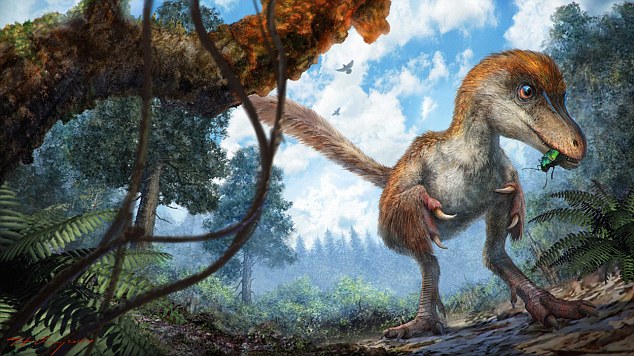
This image shows an artist's impression of the small species of dinosaur that the tail may have belonged to. The rare find sheds light on the evolution of feathers from dinosaurs to modern birds, which cannot be gleaned from normal fossil remains.
Dinosaurs had feathered, chestnut brown tails with a pale underside, a newly found specimen reveals. The tip of the tail was found preserved in an ancient blob of amber tree resin. It belonged to a small, flightless dinosaur that lived in the mid-Cretaceous period around 99 million years ago. And the rare find sheds light on the evolution of feathers from dinosaurs to modern birds, which cannot be gleaned from normal fossil remains.
The incredible discovery – plucked from a market in Myanmar – reveals the feathered tail of a non-avian theropod that perished approximately 99 million years ago. Dr Paul Barrett, from London's Natural History Museum, described it as a 'beautiful fossil'. While the feathers aren't the first to be found in amber, earlier specimens have been difficult to definitively link to their source animal.
Dr Ryan McKellar, Curator of Invertebrate Palaeontology at the Royal Saskatchewan Museum in Canada, said: 'The new material preserves a tail consisting of eight vertebrae from a juvenile. 'These are surrounded by feathers that are preserved in 3D and with microscopic detail.
'We can be sure of the source because the vertebrae are not fused into a rod or pygostyle as in modern birds and their closest relatives. 'Instead, the tail is long and flexible, with keels of feathers running down each side.' Dr McKellar added that the feathers are definitely those of a dinosaur and not a prehistoric bird.
The amber was discovered by lead author Dr Lida Xing from the China University of Geosciences at an amber market in Myanmar in 2015. It was initially thought to be plant remains and was destined to become a piece of jewellery until Xing rescued it. CT scanning and microscope investigations revealed that the tail had a chestnut-brown colouring and a pale underside. It also provided insight into feather evolution, as the specimen's feathers lack a well-developed central shaft or 'rachis'. Their structure suggests that the two finest tiers of branching in modern feathers, known as barbs and barbules, arose before a rachis formed. A chemistry analysis of the tail showed the soft tissue layer around the bones retained traces of ferrous iron, a relic left over from blood-haemoglobin proteins that were also trapped in the sample.
'Amber pieces preserve tiny snapshots of ancient ecosystems, but they record microscopic details, three-dimensional arrangements, and tissues that are difficult to study in other settings,' Dr McKellar said. 'This is a new source of information that is worth researching with intensity and protecting as a fossil resource.' He hopes future finds from the region 'will reshape our understanding of plumage and soft tissues in dinosaurs and other vertebrates.'
He concluded: 'The theropod tail reported here is an astonishing fossil, highlighting the unique preservation potential of amber. 'Importantly, in the context of bird origins, feathers and flight are key elements contributing to the success of the clade. 'With preservation in amber, the finest details of feathers are visible in three dimensions, providing concrete evidence for feather morphologies and arrangement upon the tail, as well as supporting an important role for barbs and barbules in feather evolution.'
The study was published in the journal Current Biology.
(DM)

This image shows an artist's impression of the small species of dinosaur that the tail may have belonged to. The rare find sheds light on the evolution of feathers from dinosaurs to modern birds, which cannot be gleaned from normal fossil remains.